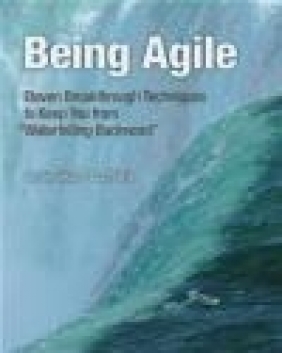Being Agile
Scott Will, Leslie Ekas
Being Agile
Scott Will, Leslie Ekas
- Producent: IBM Press
- Rok produkcji: 2013
- ISBN: 9780133375626
- Ilość stron: 224
- Oprawa: Miękka
Niedostępna
Opis: Being Agile - Scott Will, Leslie Ekas
Break the Old, Waterfall Habits that Hinder Agile Success: Drive Rapid Value and Continuous Improvement When agile teams don't get immediate results, it's tempting for them to fall back into old habits that make success even less likely. In Being Agile, Leslie Ekas and Scott Will present eleven powerful techniques for rapidly gaining substantial value from agile, making agile methods stick, and launching a "virtuous circle" of continuous improvement. Drawing on their experience helping more than 100 teams transition to agile, the authors review its key principles, identify corresponding practices, and offer breakthrough approaches for implementing them. Using their techniques, you can break typical waterfall patterns and go beyond merely "doing agile" to actually thinking and being agile. Ekas and Will help you clear away silos, improve stakeholder interaction, eliminate waste and waterfall-style inefficiencies, and lead the agile transition far more successfully. Each of their eleven principles can stand on its own: when you combine them, they become even more valuable. Coverage includes * Building "whole teams" that cut across silos and work together throughout a product's lifecycle * Engaging product stakeholders earlier and far more effectively * Overcoming inefficient "waterations" and "big batch" waterfall thinking * Getting past the curse of multi-tasking * Eliminating dangerous technical and project debt * Repeatedly deploying "release-ready" software in real user environments * Delivering what customers really need, not what you think they need* Fixing the root causes of problems so they don't recur * Learning from experience: mastering continuous improvement * Assessing whether you're just "doing agile" or actually "being agile" Being Agile will be indispensable for all software professionals now adopting agile; for coaches, managers, engineers, and team members who want to get more value from it and for students discovering it for the first time.Contents Preface xviii Acknowledgements xxi Introduction By Leslie Ekas 1 Who This Book Is For 1 What Is Our Approach? 1 What Does This Book Cover? 3 An Overview Of The Content 4 What Do You Have To Do? 6 What Benefits Can You Get from Reading This Book? 6 Who Are We? 6 Join the Conversation 7 Chapter 1 Whole Teams 9 Being agile requires whole teams because the synergy derived from cross-disciplined and cross-component teams working together enables teams to be more productive than working in isolation. By Leslie Ekas Principles 10 What Is a Whole Team? 10 Why Are Whole Teams Hard to Create? 11 Cross-Component Teams 11 Cross-Discipline Teams 12 Cross-Geographical, Cross-Cultural, Large Teams 13 Stable, Dedicated, and Protected 14 Practices 16 Start with Whole Teams 16 Maintain and Protect Dedicated Teams 16 The Conversation 17 Share the Same Truth 19 No Partial Credit 19 Offer Help 20 Metrics 20 Breakthrough 21 Summary 22 Chapter 2 Active Stakeholder Interaction 25 Being agile requires active stakeholder interaction because only your stakeholders can confirm that what you create actually meets their needs. By Scott Will Principles 26 What Is Active Stakeholder Interaction? 26 Why Can It Be Hard to Get Active Stakeholder Interaction? 27 Stakeholder Interaction Is Not a New Idea 29 Stakeholder Interaction Is Not Optional 29 Do What's Needed-And No More 30 Practices 31 Identifying Stakeholders 31 Review Epics with Stakeholders 33 Set Expectations 33 Stakeholders Should Have Skin in the Game 34 Make Stakeholder Interaction Compelling for Your Customers 35 Doing Regular Demonstrations 35 Reacting to Feedback Received 36 When Is the Development Organization a Stakeholder? 37 Customer Support Teams as Stakeholders 38 Working with Customers in Countries Other Than Your Own 39 Metrics 39 Breakthrough 40 Summary 42 Chapter 3 Queuing Theory 43 Being agile requires embracing queuing theory practices because teams achieve greater efficiency and throughput by leveraging a steady flow of small work items. By Scott Will Principles 44 Why Does Waterfall Thinking Still Linger? 44 Small Batches of Coordinated Work 45 Frequent Feedback 46 Ensure Sufficient Capacity 46 Practices 47 Small Task Sizes: 4 Hours, 8 Hours, 16 Hours 47 One User Story at a Time 48 Short Iterations 49 Metrics Should Support the Focus on Working Software 50 Metrics 50 Breakthrough 51 Summary 51 Chapter 4 No Multitasking 53 Being agile requires teams to avoid multitasking because teams are more productive when they focus. By Scott Will Principles 55 One Thing at a Time Is More Efficient 55 Flow 56 Stop Starting; Start Finishing 57 Practices 57 Team Members Are Dedicated to a Project 100% of the Time 57 One Project at a Time 58 Be a "Firewall" and Stop Being a "Fast-Forward" Button 58 Pair Programming; Pair Testing 59 Calendar Ruthlessness 59 Metrics 60 Breakthrough 61 Summary 62 Chapter 5 Eliminate Waste 63 Being agile requires eliminating waste to realize significant efficiency, productivity, and quality gains. By Leslie Ekas Principles 64 What Is Eliminating Waste? 64 Why the Focus on Eliminating Waste? 65 Technical Debt 65 Project Debt 67 Why Is It Hard to Eliminate Waste? 67 Practices 69 Get Rid of Waste... One Way or Another 69 Small Tasks 70 Build Quality In 71 Focus on Customer Value 72 Expand "Done!" Criteria 73 Handling Latent Defects 74 Stop Writing Defect Records 74 Metrics 75 Breakthrough 76 Summary 77 Chapter 6 Working Software 79 Being agile requires always having working software because it validates progress, ensures the highest levels of quality, and enables regular feedback. By Leslie Ekas Principles 80 What Is Working Software? 80 Why Is It Hard to Regularly Have Working Software? 82 Working Software Extends Test Suites 82 Practices 83 Short Iterations 83 Continuous Integration and Automation 84 Vertically Sliced Stories 85 Evolutionary Architecture and Emergent Design 86 In-House Deploys 88 Metrics 89 Breakthrough 89 Summary 91 Chapter 7 Deliver Value 93 Being agile requires delivering real value so that customers succeed with your product. By Scott Will Principles 94 Why User Stories? 94 Practices 97 The "So That" Clause 97 Vertically Sliced Stories 98 Acceptance Criteria 99 Using Velocity Effectively 100 Metrics 103 Breakthrough 103 What Exactly Is a Zero-Gravity Thinker? 104 A Real Example 106 Zero Gravity Thinking in Sum... 106 Summary 107 Chapter 8 Release Often 109 Being agile requires releasing software often so that teams learn fast and customers succeed sooner. By Leslie Ekas Principles 112 Why Release Often? 112 Do Just Enough 113 Defer Commitment 114 Why Can It Be Hard to Release Often? 116 Practices 117 Start with Shorter Release Cycles 117 Epic Stories 117 Evolutionary Product Design 119 High Value First 120 High Risk First 121 Value-Driven Development: the Outworking of Frequent Code Drops 123 Metrics 124 Breakthrough 125 Summary 128 Chapter 9 Stop the Line 129 Being agile requires that teams stop the line to solve critical problems at their core so that they do not lose time by dealing with the same problem again and again. By Leslie Ekas Principles 130 What Is Stop the Line? 130 Why Is Stop the Line Hard? 131 Practices 133 Fix Blockers 133 Reflections as a Guide 133 What if the Problem Is Too Big to Stop the Line? 133 Metrics 134 Breakthrough 139 Summary 141 Chapter 10 Agile Leadership 143 Being successful with agile requires leaders who learn, participate in, and experiment with agile so that they lead with an agile mindset and react with agile instincts. By Leslie Ekas Principles 145 Agile Leadership 145 Why Is Agile Leadership Hard? 146 Practices 147 Learn Agile, Experience Agile, Develop Agile Instincts 147 Enable and Protect 148 Help Your Team Learn, Let Your Team Fail 149 Set Priorities, Provide Boundaries, and Let the Team Figure Out How 151 A Single, Visible View of the Truth 153 Metrics 154 Breakthrough 154 Summary 155 Chapter 11 Continuous Improvement 157 Being agile requires continuous improvement because teams that continue to learn, adapt, and evolve are more productive and competitive. Agile is a never-ending journey of getting better. By Scott Will Principles 158 Why Is Continuous Improvement Important? 158 Why Is Continuous Improvement Hard? 159 There Is No Such Thing as "100 Percent Agile" 159 Realize That You Will Learn New Things as a Project Progresses 160 You Need to Set Time Aside to Sharpen Your Axe 160 Focus on Small, On-Going Improvements 161 Learn from Your Mistakes; Don't Make Them Again 162 Fail Fast 162 Management Needs to Actively Promote Innovation 162 Practices 164 Reflections 164 Value Stream Mapping 166 Addressing Reluctance 167 The "Art" of Continuous Improvement 167 Share 169 Metrics 169 Breakthrough 169 Summary 170 Appendix By Scott Will 173 Exploring Your Agility: A Brief, Annotated Questionnaire 173 What Would You Be Willing to Give Up? 174 Questions on Various Agile Practices 175 How Long Are Your Iterations? 175 How Often Do You Build? 176 What Disciplines Are on Your Teams? 176 Do You Carry a Defect Backlog? 176 What Do You Automate? 177 Do You Conduct Status Meetings? 177 Are You Delivering Value to Your Customers? 178 Do You Get to "Done!" Each Iteration? 178 Are You Getting Better? 178 Concluding Thoughts 178 Index 179
Szczegóły: Being Agile - Scott Will, Leslie Ekas
Tytuł: Being Agile
Autor: Scott Will, Leslie Ekas
Producent: IBM Press
ISBN: 9780133375626
Rok produkcji: 2013
Ilość stron: 224
Oprawa: Miękka
Waga: 0.36 kg





























